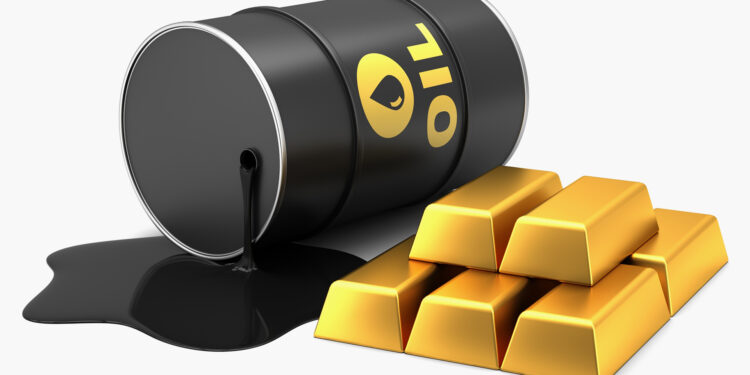4/21/2025–|Last update: 4/21/202504:07 PM (Mecca time)
The yellow metal recorded a new summit during Monday’s trading, driven by the decline in the dollar and the fears of recession, which prompted the dealers to take shelter with safe haven, while oil prices fell with investors focusing again on fears that American customs duties will lead to economic challenges that reduce the growth of fuel demand.
gold
Gold touched its highest level ever today in light of the dollar’s decline to the lowest level in 3 years and fears of the recession caused by the trade war between the United States and its main partners, which prompted investors to go towards a safe haven.
The yellow metal increased in instant transactions 2.75% to 3419.90 dollars an ounce in the latest transactions, its highest level ever, and US gold futures rose 2.77% to $ 3420.60, after registering $ 3422.90 during today’s trading.
The dollar index reached its lowest level in 3 years, which increased the attractiveness of gold for other currencies.
The Boeing 737 Max has returned to a Chinese airline to the United States yesterday, in light of the escalation of the trade war between the two largest economies in the world.
Last week, (US President Donald) Trump ordered an investigation to consider the need to impose possible new customs duties on all imports of American basic minerals, in a great escalation of his displacement with his global trading partners and an attempt to pressure China in this sector.
The gold, which is usually seen as a way to hedge from the high inflation by more than 27% since the beginning of the year.
Oil
Oil prices have decreased by more than 2% today, with investors focusing again on fears that US customs duties will lead to opposite economic winds that reduce fuel demand growth.
Brent crude futures fell $ 1.62, 2.38%, to $ 66.33 a barrel, with the latest transactions, after closing at an increase of 3.2% on Thursday. The West Texas Intermediate crude fell 2.5% to $ 63.06 a barrel, after closing at an altitude of 3.54% in the previous session.
Thursday was the last day of settlement last week due to the great Friday holiday.
John Rong, the market’s strategic analyst at IG, said that the general trend is still in decline, “as it seems that investors find it difficult to persuade themselves to improve the expectations of supply and demand, especially in light of the impact of customs duties on global growth and the rise in OPEC Plus.”
It is still expected that OPEC Plus – which includes the Organization of Petroleum Exporting Countries (OPEC) and allies, including Russia – will be expected to produce 411 thousand barrels per day starting in May, but some expected increase may be compensated by a reduction in countries that exceeded their agreed share.
Prices also decreased with the decline of some concerns about supplies, after indications of the progress of nuclear talks between the United States and Iran on Saturday.
Iranian Foreign Minister Abbas Araqji said that Iran and the United States agreed to start setting a framework for a possible nuclear agreement, after talks that a US official described as “very good progress.”
The progress in nuclear discussions comes in the wake of additional sanctions imposed by the United States last week, which included a special Chinese refinery because of its dealings with Iranian crude oil, which increased the pressure on Tehran in the midst of the talks.
Fears – regarding the lack of Iranian oil supplies and hopes to reach a trade agreement between the United States and the European Union – both Brent crude and West Texas Intermediate crude to rise by 5% last week, registering their first weekly gain in 3 weeks.
However, the markets are still concerned about the repercussions of American customs duties and the trade war between the United States and China.
Investors are awaiting the issuance of a number of American data this week to come out with indicators about the economic situation, including the Procurement Manager Index for the manufacturing and services sectors for April.
The Interfax News Agency said – early in the morning – that the Russian Ministry of Economy reduced its expectations for the average price of Brent crude for 2025 by about 17% from its expectations in September of what will be the price this year.
The agency said that the Russian ministry believes in the basic scenario of economic expectations for the year 2025 that the average price of Brent crude is approximately 68 dollars per barrel, a decrease of $ 81.7 from what it assumed in its expectations in September.
The ministry expects the price of Urals, the main oil mix in Russia, will reach $ 56 a barrel for $ 69.7 that Moscow relied in its budget for 2025.



